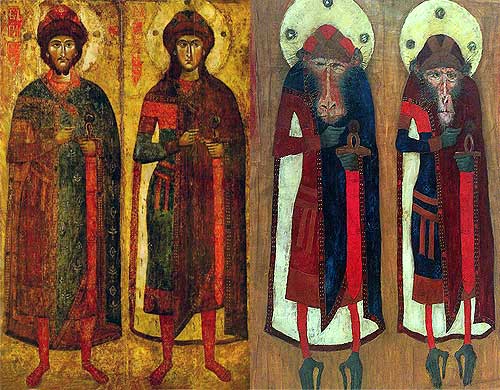Eduardo Javier García López
Si buscas
hosting web,
dominios web,
correos empresariales o
crear páginas web gratis,
ingresa a
PaginaMX
Por otro lado, si buscas crear códigos qr online ingresa al Creador de Códigos QR más potente que existe




Fashion in early Russia
Clothing in early Rus', as in other cultures, reflected societal norms, and the individual's originality and conception of beauty, and indicated rank, wealth, profession, family status and locality. (Pushkareva97)
Early clothing styles were influenced by the close connections with Byzantium and other cultures. Cut was simple, free-flowing, full but not too wide, and long but not as long as in Byzantium. Nearly all clothing was put on over the head because it didn't open all the way down the front. The clothing also usually lacked large front closures. (Kireyeva)
The climate of Rus was quite cold. Long winters and cool summers made closed up clothing with many layers and furs practical. (Kireyeva)
Children's Clothing:
About children’s clothing in the 9th-13th century, information is very little. Judging by what we said about the ponyova and tribal ornaments, rural girls, and possibly also city girls, went about in one shirt [rubashka]. Some later information allows us to suppose that also little boys, until reaching full maturity, did not wear pants (Maslova, 1956, page 555), consequently they also went in one shirt [rubashka]. But a young prince was dressed just as the adults only without the korzna [cloak] (at least so he is depicted on the miniature from the Izbornik of Svyatoslav) (see p. 1 of the colored insert). (Rabinovich)
One important difference in urban clothing by the 13-17th cent. was the clear evidence of clothing specifically for children. The opinion of researchers about this, is that a unique garment of children of both sexes was a long rubakha, based, probably, on study of peasant clothing of later time and on one statement of A. Olearij. In Ladoga in 1634 this traveler was astonished that “all – both girls and boys – were in short-cut hair, with curls, haing from both sides, and in long rubakhas, such that never were distinguished boys from girls”. About this same says also several depictions about which will discuss ahead. But in written sources of the 17th cent., we find not only “rubashki child’s” or “child’s” [ревачьи vs детинные], but also “two kaftantsa valuable children’s”. And “shuba sheepskin child’s new” and even “tafejka [skullcap?] childs broadcloth red”. True, these records are rare and usually related to wealthy families, but all the same, one must think that if children of peasants and the urban poor darted about in one rubashka, that for children of nobles and generally wealthy people were sewn clothing in general the same as for adults. Regarding shoes, one can say more definitely, because finds of children’s shoes among archeological excavations are frequent. For children were sewn the same boots as for adults, but obviously, smaller in size. In excavations, therefore, one can find, for example, the front of a large men’s boot, from which was cut out a small child’s sole. (Rabinovich)
Childrens clothing was recommended by the Domostroi to sew for growth: “the edges [кроячи] turn up a vershok [about 2 inches] or two or three at the hem and along edges and along seams and along sleeves, and as grows out the years 2 or 3 or 4, opening the seam of that garment and turning it out straight again becomes good”. (Rabinovich)
Ceremonial Costume:
Over the rubakha was worn a long tunic reaching to the ankles with narrow sleeves, then over that a dalmatica with wide straight sleeves shorter than the sleeves of the tunic. The dalmatica was considerably shorter than the tunic reaching approximately the calf, and it was belted at the waist. Over the dalmatica was often worn a mantle (fastened in front) or, more rarely, a korzna (fastened on the right shoulder). The headdress was the nachil'nik (diadem) or venets (or fur hat) for maidens, and the povoinik, veil and hat (venets, kokoshnik, fur hat) for married women. (Stamerov) or (Kireyeva).
The cloak-cape was long preserved in the costume of ancient Russian women in celebratory clothing. Comparing the Radzivillovski Chronicle with frescos of Sophia Cathedral of Kiev, indicates that the over garment was loose and long, consisting of a straight, usually belted, dress (the so-called dalmatica?), supplemented with "raspashnym" clothing (robes open-down-the-front, often worn over the shoulders like a cloak), a collar, a "podol" (hem) and a "styk" (joint?) of fabric which was otorocheny (edged) with a border (kajma). On frescoes of St. Sophia's in Kiev, the women were dressed in just such dresses and edged cloaks (plashi). Sometimes, that edge or border was sewn on as a wide silk braid, embroidered with gold. Galloon/braids of such type are found in burials. (Pushkarva89)
Fabrics and Furs:
The primary fabrics used were wools and linens (including hemps), as with the rest of Europe in the middle ages. Linen ranged from coarse to fine woven. Coarse, homespun wool (sermyaga or seryachini) was used for peasant clothes and also for the undergarments and everyday clothes of the merchant classes, and even boyars. (Kireyeva and Stamerov)
Fine imported fabrics (pavolok) were reserved for outer garments and festival costumes. The main imported fabrics were taffeta, brocade, stamped velvet, golden velvet (velvet embroidered with gold thread). (Kireyeva)
Fur was used extensively. Winter clothes were lined with it, and trims and edgings were made of it. Peasants used wolf, fox, bear, rabbit, squirrel and especially sheepskin. Nobility enjoyed beaver, otter, sable, and marten. (Stamerov)
Color:
The clothing of Rus was very colorful. The raw color of unbleached linen predominated in peasant clothes. White would appear in various parts of the costume. Linen could be dyed, especially if intended for the nobility, and called “krashenin”. Colors included blue, green and red. Imported pavalok fabrics generally had Byzantine style ornamentation in dark-red (cinnabar), crimson (carmine), purple and azure. (Stamerov)
Tu Sitio Web Gratis
© 2025 Eduardo Javier García López12279